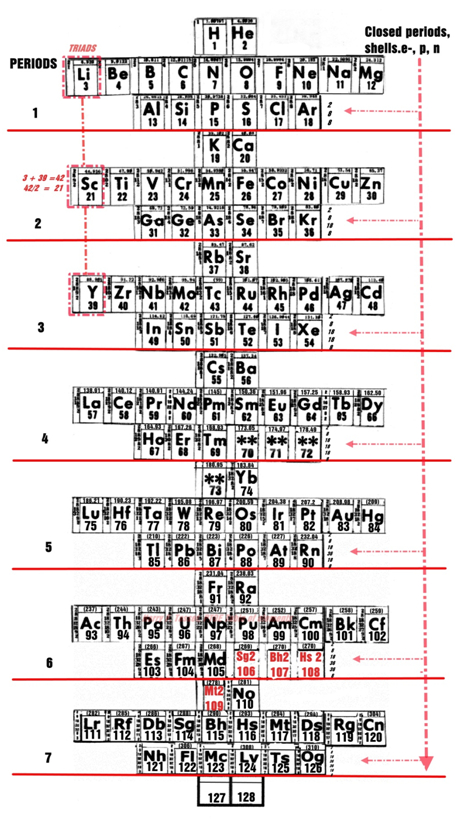The Possible Dream becomes a Reality

(Image by Harry F. Tasset, all rights reserved.
A breakthrough finding is that there are more than 42 perfect atomic number triads in the NEW table! The 4th and 6th red arrows on the right side of the table show the two zero-points singularities where the quantum field collapses. This new Periodic Table of the Elements represents over 50 years of trial and error. Little did I know that it would take the perfect form above, but when I look at the closet full of papers, I realize it could be no other way. As you read on, you will see that this new table, with its 8 unknown elements, becomes apparent.
The below-referenced article was responsible for propelling my research into the periodic table of the elements to a new level and confirmed the physics behind the creation of these mysterious new elements. As you will see in my book, these 8 heavy elements begin to take their rightful place in a radically new periodic table. At the time of this article, I was desperately trying to confirm that the missing elements were indeed in the heavy category near the Lanthanoids and Actinoids, so when I read that the nuclei of these exotic nuclei get more compact as they get heavier, I knew that I was on the right path.
Here is the article:
“….a set of exotic nuclei, which are not found in the Periodic Table.” This research is being conducted by The Indian Lattice Gauge Theory Initiative, (ILGTI) https://phys.org/news/2019-10-deuteron-like-heavy-dibaryonsa-exotic-nuclei.html.
“We report the first lattice quantum chromodynamics (QCD) study of deuteronlike (np-like) dibaryons with heavy quark flavors. These include particles with the following dibaryon structures and valence quark contents: ΣcΞcc(uucucc), ΩcΩcc(sscscc), ΣbΞbb(uububb), ΩbΩbb(ssbsbb), and ΩccbΩcbb(ccbcbb), and with spin (J) parity (P), JP≡1+. Using a state-of-the-art lattice QCD calculation, after controlling relevant systematic errors, we unambiguously find that the ground state masses of dibaryons ΩcΩcc(sscscc), ΩbΩbb(ssbsbb), and ΩccbΩcbb(ccbcbb) are below their respective two-baryon thresholds, suggesting the presence of bound states that are stable under strong and electromagnetic interactions. We also predict their masses precisely. For dibaryons ΣcΞcc(uucucc), and ΣbΞbb(uububb), we could not reach to a definitive conclusion about the presence of any bound state due to large systematics associated with these states. We also find that the binding of these dibaryons becomes stronger as they become heavier in mass. This study also opens up the possibility of the existence of many other exotic nuclei, which can be formed through the fusion of heavy baryons, similar to the formation of nuclei of elements in the periodic table.”
The above article suggests that the formation of a new periodic table of elements must be considered. As you will see in my book, there are 8 spaces in the middle of the table where the exotic nuclei described above, belong. Since this initial article, other scientists are now saying that a new table actually exists.
The below scientists suggest that Starship Enterprise may only be several decades away.
Physicist Alan Holt, of NASA Johnson Space Center, suggests “generating extremely coherent electromagnetic energy patterns to affect the gravitational constant around a craft, and then setting up a resonance with a distant space-time point, tunneling through the speed of light energy barrier, almost instantaneously to a distant star system.”
F.E. Alzofon suggested an alignment and disalignment cycle of dynamic nuclear orientation, which would create an electrogravity coupling, to escape the Earth’s gravitational field cheaply without propellant.”
“The zero-point-energy of the vacuum of outer space could power the starships of the future. Gravity itself could be a side effect of ZPE according to H.E. Puthoff, as reported in Physical Review Letters. Inertia might also be a drag on the ZPE force. This ZPE could be used to alter a spacecraft’s gravitational constant, as well as propel it to light speed and beyond.” Among the scientist reporting is Hal Putoff, Alan Holt, F.E. Alzofon, Barry C. Mingst.
http://www.intalek.com/Index/Projects/Research/PRA94.pdf
Bernhard Haisch is a staff scientist at the Lockheed Martin Solar and Astrophysics Laboratory in California and a regular visiting fellow at the Max-Planck-Institut fuer extraterrestrische Physik in Garching, Germany. Alfonso Rueda is a professor of electrical engineering at California State University in Long Beach. H. E. Puthoff is director of the Institute for Advanced Studies at Austin, Texas.
Here is the link for a recent book that details the new space engines. https://books.google.com/books?id=dJNHswEACAAJ&dq=field+propulsion+system+for+space+travel&hl=en&newbks=1&newbks_redir=1&sa=X&ved=2ahUKEwiJvuSl08n3AhURg2oFHUVbCAYQ6AF6BAgDEAI
Book by Takaaki Musha and Yoshinari Minami, 2011
o other way.

Feedback/Errata